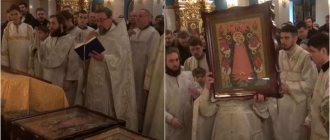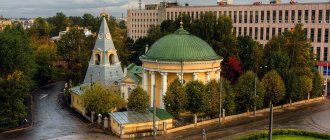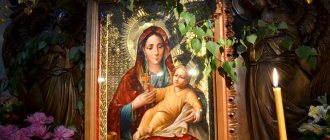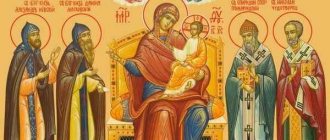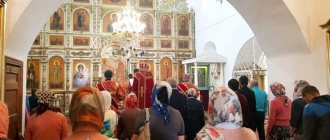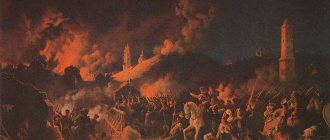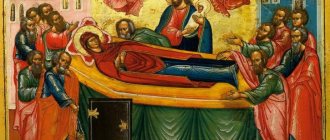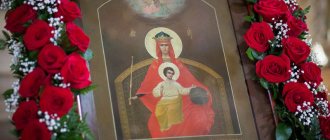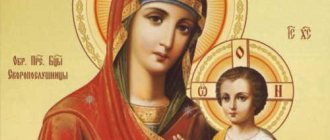Icon of the Mother of God of Arapet (Arabian, O All-Sung Mother)
The Arabet or Arabian icon of the Mother of God is one of the most ancient icons, but is known only by name. No information has been preserved about the place and time of her appearance. There are only guesses and assumptions on this issue. Some attribute the appearance and glorification of the icon to the beginning of the 4th century, namely to the year 301. According to other sources, her appearance dates back to an earlier time - the 1st century, and this event coincides with the moment when the Holy Apostle Thomas spread the light of the Gospel teaching in India.
Another name of the icon - “O All-Sung Mother” is due to the fact that the edge of the “moire” maforia of the Mother of God is decorated with a border with the text of the stanza of the 13th kontakion of the Great Akathist in Church Slavonic: “O All-Sung Mother, who gave birth to all the saints, the Most Holy Word, who accepted the present offering , deliver everyone from all misfortunes, and remove the coming torment, crying out to You: Alleluia.” In addition, on the border of the maforia of the Mother of God you can read the words with which the Great Akathist begins: “To the chosen Voivode, victorious, as if she got rid of the evil ones...”. In the Russian icon painting tradition, this iconography has been known since the 17th century.
The earliest image of the Mother of God “O All-Sung Mother” is found on several sheets of the Siya facial icon-painting original of the 17th century. On one of them the icon is called “Arapskaya”. In the icon painting practice of the early 20th century. you can also find the name “Arabian”. The icon is a half-length image of the Mother of God in a three-quarter turn, easily supporting the Infant Christ with her palms at the level of his forearms. The Savior’s hands are raised and lie on the chest of the Mother of God. Sometimes the head of the Mother of God is crowned with a fabulous royal crown. The vestments of the Blessed Virgin usually consist of a red-brown chiton and a cherry “cloud” maforia, which is a symbol of the heavenly world. On the shoulders and head of the Mother of God, instead of the usual stars - symbols of virginity - three medallions with the heads of angels are depicted, which are sometimes interpreted by Orthodox theologians as an ancient symbolic image of the Trinity. Perhaps, in the imagination of the 17th century. This iconographic reading of the image was associated with the East, Egypt and Palestine, which was reflected in the naming of the icon “Arab” or “Arabian”.
The icon from the collection of the Tretyakov State Gallery depicts the Mother of God without a crown and a very rare left-sided position of the Infant Savior. Christ is dressed only in a loincloth and himation, which in this icon has a unique “cloud” shape and, as if enveloping, supports and hides Christ.
Catalog of icons on the website PravIcon.com
Description of the Arapetskaya icon
Source: Disc “Orthodox Church Calendar 2011” from the publishing house of the Moscow Patriarchate [2011]
The Arapetskaya or Arabian Icon of the Mother of God is one of the most ancient icons, but is known only by name. No information has been preserved about the place and time of her appearance. There are only guesses and assumptions on this issue. Some attribute the appearance and glorification of the icon to the beginning of the 4th century, namely to the year 301. According to other sources, her appearance dates back to an earlier time - the 1st century, and this event coincides with the moment when the Holy Apostle Thomas spread the light of the Gospel teaching in India. Another name of the icon - “O All-Sung Mother” is due to the fact that the edge of the “moire” maforia of the Mother of God is decorated with a border with the text of the stanza of the 13th kontakion of the Great Akathist in Church Slavonic: “O All-Sung Mother, who gave birth to all saints, the Most Holy Word, the current Having accepted the offering, deliver everyone from all misfortunes, and remove the coming torment, crying out to You: Alleluia.” In addition, on the border of the maforia of the Mother of God you can read the words with which the Great Akathist begins: “To the Ascended Vo[...]
Icon of Arapetskaya (Arabian, O All-Petaya Mother) - description
Source: Website “Miracle-Working Icons of the Most Holy Theotokos”, author - Valery Melnikov [2011]
The Arapetskaya, or Arabian, icon of the Mother of God is one of the most ancient icons, but is known only by name. No information has been preserved about the place and time of her appearance. Some attribute its appearance and glorification to the beginning of the 4th century, naming a specific year - 301. According to other sources, the appearance of the Arapet icon dates back to an earlier time - the 1st century, and is associated with the Holy Apostle Thomas during his stay in India. Another name of the icon - “O All-Sung Mother” - follows from the Church Slavonic inscription on the border of the maforium of the Mother of God, stanza of the 13th kontakion of the Great Akathist of the Most Holy Theotokos: “O All-Sung Mother, who gave birth to all the saints, the Most Holy Word, having accepted the present offering, delivered from all misfortunes everyone, and the torment that is to come, crying out to You: Hallelujah.” The word Vsepetaya means “glorified by all.” The All-Singing Mother of God is also called in the Canon of the prayer service to the Theotokos (canto 3, canto 4). On some icons, the Mother of God is crowned with a wide royal crown. Her vestments usually consist[...]
Description of the Arapetskaya (Arabian, O All-Sung Mother) icon
Source: Handbook of a church clergyman, author - S.V. Bulgakov [1913]
Arabian or Arapetskaya St. the icon became famous in 301; according to some, its appearance dates back to the 1st century. The Mother of God is depicted on it bowing Her head to the Infant God sitting on Her right hand, whose face is turned to those praying, and whose hands are stretched out to the Mother of God.
Description of the Arapetskaya (Arabian, O All-Sung Mother) icon from the book by E. Poselyanin
Source: Book “E.
Villager. Our Lady. Description of Her earthly life and miraculous icons" [1914] The Arabian or Arapet icon of the Mother of God is one of the most ancient icons, but is known only by name. No information has been preserved about the place and time of her appearance. There are only guesses and assumptions on this issue. Some attribute its appearance and glorification to the beginning of the 4th century, precisely to the year 301. According to other news, her appearance dates back to an earlier time - the 1st century, and this event coincides with the moment when St. the Apostle Thomas spread the light of the gospel teaching in India.
ARAPET ICON OF THE MOTHER OF GOD
[Arabian, “Oh, All-Singing Mother”] (celebrated September 6), is one of the most ancient revealed icons of the Mother of God. Reliable information about A. and. not preserved. According to legend, the time of the appearance of the icon is associated with the sermon in the 1st century. ap. Thomas of the Gospel teaching in India (Poselyanin. P. 567). According to another version, the icon appeared in the beginning. IV century, in 301 (Ibid.) or 322 (Rovinsky. P. 675).
Arapet Icon of the Mother of God. 2nd half XIX century (CAC MDA) Arapet Icon of the Mother of God. 2nd half XIX century (CAC MDA)
Iconographic type of A. and. - Hodegetria Aristerus (Infant Christ on the left hand of the Mother of God), the Child is dressed in red clothes, the upper part of the body is naked, both legs are not covered (in some images only the heel of the right foot is visible). Distinctive features of the iconography are the heads of angels in medallions depicted on the maforia in the places of stars, the text of the last ikos of the akathist to the Mother of God (“Oh, All-Singing Mother”) inscribed in the border, and the fabric of the maforia decorated with images of clouds. The listed features are found both together (icons of the 1st half - mid-19th century (SPbDA Museum), 2nd third of the 19th century (GNIIR), 2nd half of the 19th century (CAM MDA)), and separately; on the icon XIX century (Private collection. Moscow) - in the right hand of the Child there is a scroll.
Get along with A. and. is given under 6 Sep. in the Siya icon-painting original, last. Thursday XVII century, mention of it is also contained in the Klintsovsky original of the book. XVIII century
A. and. presented in the collection of miraculous icons of the Mother of God in engravings of the beginning. XVIII century works by G. P. Tepchegorsky and on icons from the 18th century to the beginning. XX century, for example. on the Vologda icon. XVIII - beginning XIX century (CherMO), “The Dormition of the Mother of God and the set of miraculous icons of the Mother of God” of the 19th century. (Tretyakov Gallery), icon con. XIX - early XX century (CAC MDA). The iconography of these monuments differs from the traditional one; in particular, the Infant Christ is depicted sitting on the right hand of the Mother of God; there are no characteristic images on the maforia.
According to Archbishop. Sergius (Spassky), celebration of A. and. was not noted in Greek. and Russian monthly books (Mesyatseslov. T. 2. P. 274, T. 3. P. 658), including in the official. calendars of the Russian Orthodox Church of the 19th century. In modern calendar of the Russian Orthodox Church celebration of A. and. indicated and takes place on September 6th.
Lit.: Rovinsky. Folk pictures. Book 4. P. 675; Villager E. Mother of God. P. 567; Kondakov. Iconography of the Mother of God. T. 3. P. 53; Ebbinghaus A. Die altrussischen Marienikonen-Legenden. B., 1990. S. 47; Bentchev I. Handbuch der Muttergottesikonen Russlands. Bonn, 1992. S. 27; The spiritual environment of Russia: Singing books and icons of the 17th - early years. XX century M., 1996. P. 129. Cat. 41; Revived masterpieces of the Russian North: Research. and restoration of artistic monuments. culture of the Vologda region: Exhibition. M., 1998. P. 62.
E.A.I.
Arapet Icon of the Mother of GodDays of remembrance: September 6
The Arabet or Arabian icon of the Mother of God is one of the most ancient icons, but is known only by name. No information has been preserved about the place and time of her appearance. There are only guesses and assumptions on this issue. Some attribute the appearance and glorification of the icon to the beginning of the 4th century, namely to the year 301. According to other sources, her appearance dates back to an earlier time - the 1st century, and this event coincides with the moment when the Holy Apostle Thomas spread the light of the Gospel teaching in India. Another name of the icon - “O All-Sung Mother” is due to the fact that the edge of the “moire” maforia of the Mother of God is decorated with a border with the text of the stanza of the 13th kontakion of the Great Akathist in Church Slavonic: “O All-Sung Mother, who gave birth to all saints, the Most Holy Word, the current Having accepted the offering, deliver everyone from every misfortune, and remove the coming torment, crying out to You: Alleluia.” In addition, on the border of the maforia of the Mother of God you can read the words with which the Great Akathist begins: “To the chosen Voivode, victorious, as if she got rid of the evil ones...”. In the Russian icon painting tradition, this iconography has been known since the 17th century. The earliest image of the Mother of God “O All-Sung Mother” is found on several sheets of the Siya facial icon-painting original of the 17th century. On one of them the icon is called “Arapskaya”. In the icon painting practice of the early 20th century. you can also find the name “Arabian”. The icon is a half-length image of the Mother of God in a three-quarter turn, easily supporting the Infant Christ with her palms at the level of his forearms. The Savior’s hands are raised and lie on the chest of the Mother of God. Sometimes the head of the Mother of God is crowned with a fabulous royal crown. The vestments of the Blessed Virgin usually consist of a red-brown chiton and a cherry “cloud” maforia, which is a symbol of the heavenly world. On the shoulders and head of the Mother of God, instead of the usual stars - symbols of virginity - three medallions with the heads of angels are depicted, which are sometimes interpreted by Orthodox theologians as an ancient symbolic image of the Trinity. Perhaps, in the imagination of the 17th century. This iconographic reading of the image was associated with the East, Egypt and Palestine, which was reflected in the naming of the icon “Arab” or “Arabian”. The icon from the collection of the Tretyakov State Gallery depicts the Mother of God without a crown and a very rare left-sided position of the Infant Savior. Christ is dressed only in a loincloth and himation, which in this icon has a unique “cloud” shape and, as if enveloping, supports and hides Christ.
LiveInternetLiveInternet
Sunday, October 19, 2014 09:29 + in quotation book The Arabet, or Arabian, icon of the Mother of God is one of the most ancient icons, but is known only by name. No information has been preserved about the place and time of her appearance. Some attribute its appearance and glorification to the beginning of the 4th century, naming a specific year - 301. According to other sources, the appearance of the Arapet icon dates back to an earlier time - the 1st century, and is associated with the Holy Apostle Thomas during his stay in India. Another name of the icon - “O All-Sung Mother” - follows from the Church Slavonic inscription on the border of the maforium of the Mother of God, stanza of the 13th kontakion of the Great Akathist of the Most Holy Theotokos: “O All-Sung Mother, who gave birth to all the saints, the Most Holy Word, having accepted the present offering, delivered from all misfortunes everyone, and the torment that is to come, crying out to You: Hallelujah.” The word Vsepetaya means “glorified by all.” The All-Singing Mother of God is also called in the Canon of the prayer service to the Theotokos (canto 3, canto 4). On some icons, the Mother of God is crowned with a wide royal crown. Her vestments usually consist of a red-brown chiton and a cherry “cloud” maforia. Along the border of the maforia are the words of the above chant, and on the shoulders and head of Mary, instead of the traditional stars, three main angels are often depicted, which are sometimes interpreted as an ancient symbolic image of the Trinity. "Oh All-Singing Mother"
This naming of the icon is due to the fact that on the border of the maforia of the Mother of God the stanza of the 13th kontakion of the Great Akathist is written in Church Slavonic: “O all-sung Mother, who gave birth to all the saints, the Most Holy Word, having accepted the present offering, deliver everyone from all misfortunes, and remove the torments that are to come , crying Ti: Hallelujah.” In the Russian icon painting tradition, this iconography has been known since the 17th century. Its appearance was not associated with the glorification of any particular shrine. The image is typical for the 17th century. a complicated iconographic interpretation was supposed to reveal a symbolic reading of the hymnographic theme. The earliest image of the Mother of God “O All-Sung Mother” is found on several sheets of the Siya facial icon-painting original of the 17th century. On one of them the icon is called “Arapskaya”. In the icon painting practice of the early 20th century. you can also find the name “Arabian”. The icon is a half-length image of the Mother of God in a three-quarter turn, easily supporting the Infant Christ with her palms at the level of his forearms. The hands of Christ, one of which is indicated only by a hand at the level of the face, are raised and lie on the chest of the Mother of God. Mary is often crowned with a wide royal crown. Her vestments usually consist of a red-brown chiton and a cherry “cloud” maforia, which is a symbol of the heavenly world. Along the border of the maforium are the words of the above chant, and on the shoulders and head of Mary, instead of the traditional stars, three main angels are depicted, which are sometimes interpreted by Orthodox theologians as an ancient symbolic image of the Trinity. Perhaps, in the imagination of the 17th century. This iconographic reading of the image was associated with the East, Egypt and Palestine, which was reflected in the naming of the icon “Arab” or “Arabian”. It is known that in the 19th century. The celebration of the icon took place on October 6. Distinctive features of the icon from the Tretyakov Gallery collection are the image of Mary without a crown and the very rare left-sided position of the Child. The attire of Christ emphasizes the “passionate” perception of the image: He is dressed only in a loincloth and himation, which in this icon has a unique “cloud” shape and, as if enveloping, supports and hides Christ. It is also noteworthy that in addition to the 13th kontakion, on the border of the Mother of God’s maforium there are the words with which the Great Akathist begins: “To the chosen victorious governor, as if she had gotten rid of the evil ones, I give thanks...”
| Categories: | Orthodoxy/Prayers
video |
Cited 2 times Liked by: 2 users
Like share
0
Like
- 2
I liked the post - Quoted
- 0
Saved
- Add to quote book
- 0
Save to links
Liked2
0
